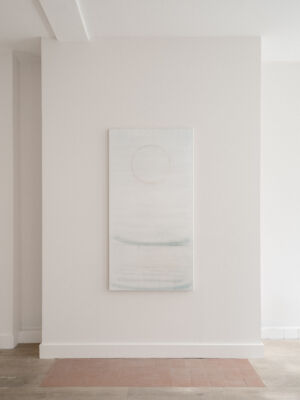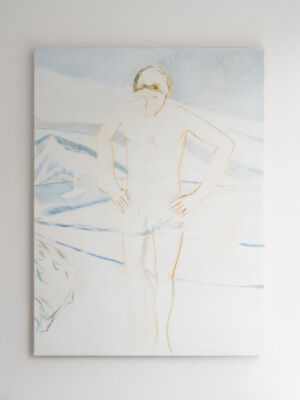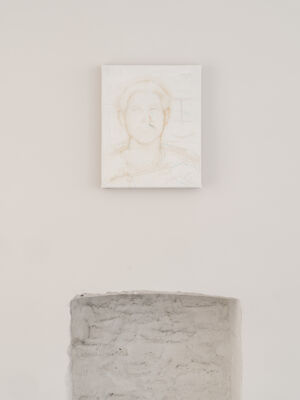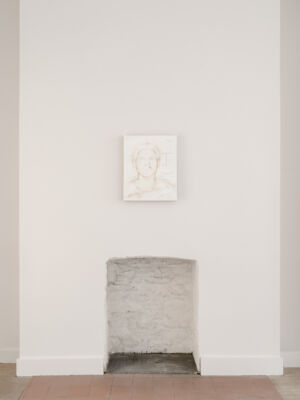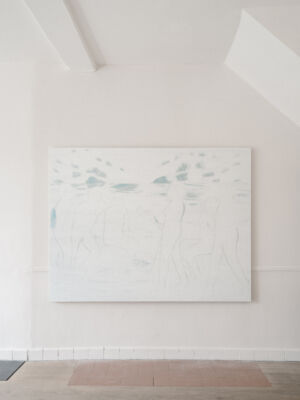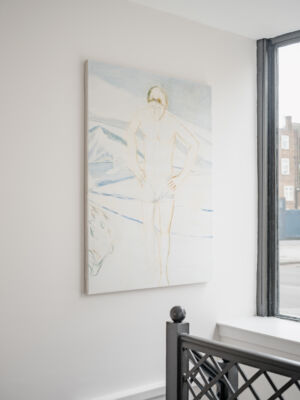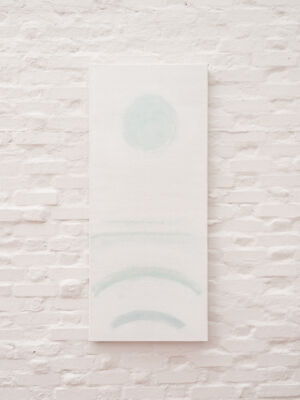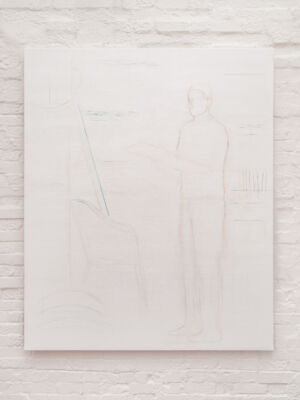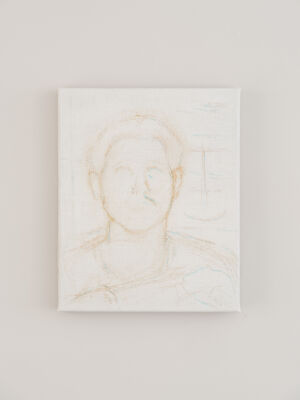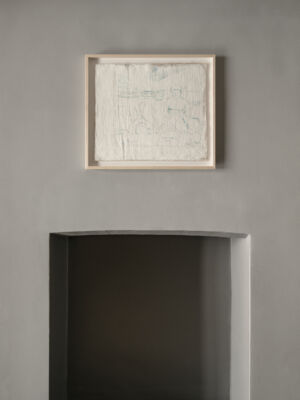Adam Leef
Light Presences
Curated by Jenn Ellis
February 7th – March 2nd, 2025. 200 Battersea Park Rd, SW11 4ND London

‘Light Presences’, Adam Leef. From left to right: ‘Fernanda‘, 2023. Ink on paper. ‘Bathers‘, 2019-2023. Oil and charcoal on canvas. Photography by James Retief
Exploring moments of expression, gesture, pace and landscape, ‘Light Presences’ is the first major solo exhibition in London by Adam Leef. Presenting a range of his oil paintings and works on paper, the show, curated by Jenn Ellis, introduces his key tenets of gesturality, art history, memory and space. Intimate in nature, ‘Light Presences’ displays two of Leef’s recurring motifs over the last four to five years: self-portraits and depictions of bathers. Interested in and sensitive to these themes being tropes of art history, Leef approaches paper and canvas with sensitive and deliberate articulation. With each stroke, Leef strives for clear, simple and fundamental expression – an approach that reflects a certain tender, delicate and integral way of being, and seeing.
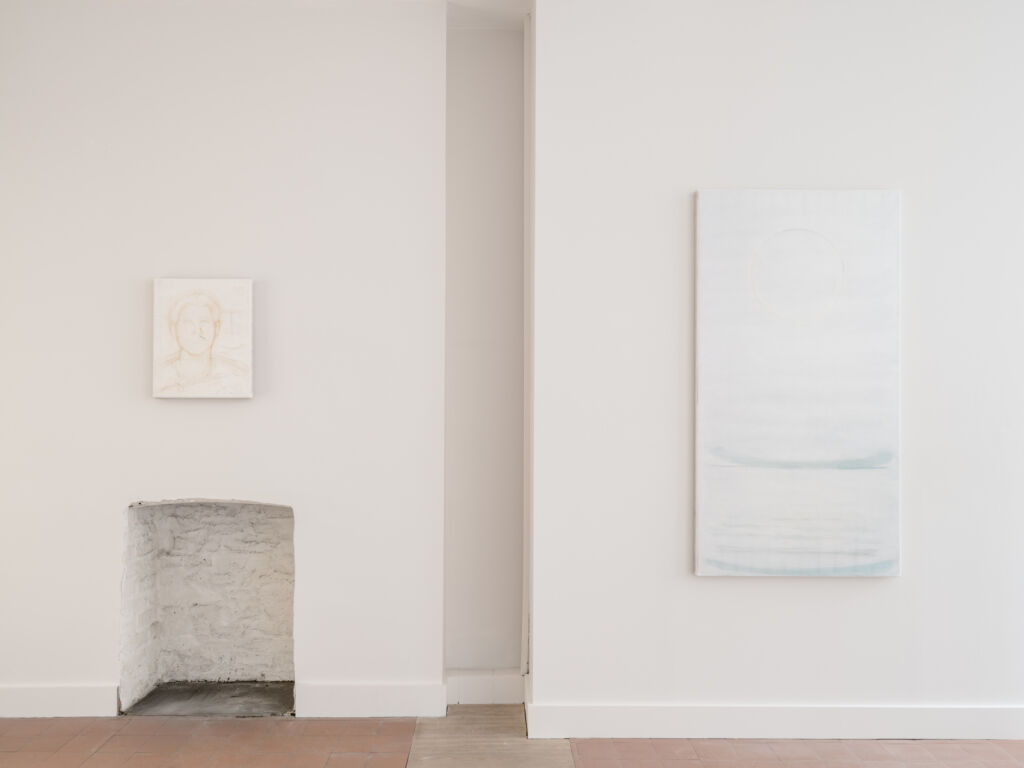
‘Light Presences’, Adam Leef. From left to right: ‘Light Self Portrait‘, 2022-2024. Oil and wax pastel on canvas. ‘(Bright) Sun and Waves‘, 2024, oil and wax pastel on canvas. Photography by James Retief
Growing up, the Mediterranean was Adam Leef’s original muse. Its ripples and vastness, its tonal hues and the profundity of its everchanging expression. Born in Jerusalem before moving to Tel Aviv and now London, Leef was raised in a musical family and saw tones and rhythm, as well as colour, shape and form. Trained in a European Classical methodology, Leef adopted the historical technique of painting ‘en plein air’, treating the landscape as his atelier and articulating what he saw before him, as well as working in his studio. Nodding to landscape masters from Paul Cézanne to Joseph Constable, Leef remarked that through each you could feel where they were; it was a sensorial experience and interlocution between painter and subject.
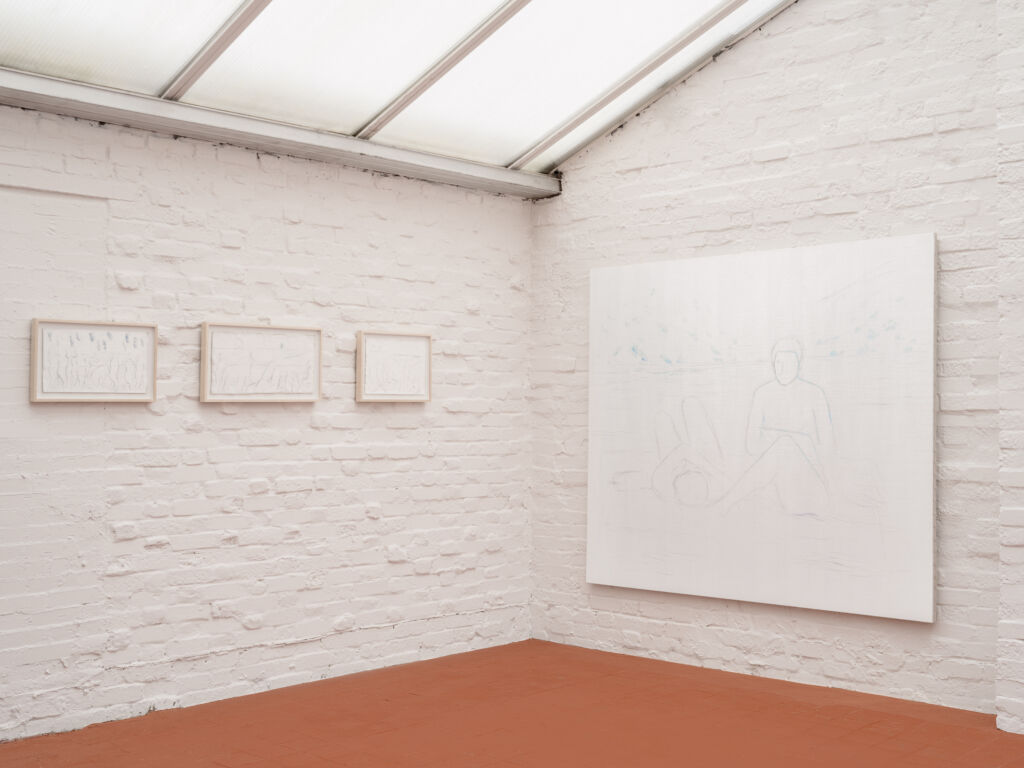
From left to right: ‘Bathers Parading‘, 2024. Oil and pencil on canvas. ‘Bathers in a Landscape‘, 2023 -2024. Oil and charcoal on canvas. ‘Bathers in a Landscape‘ 2023-2024. Oil on canvas. ‘Couple at Sea‘, 2023-2024 Oil and Charcoal on Canvas. Photography by James Retief
Drawing on the ideas of conversation, exchange and expression, there is a repeated intimacy to Leef’s works. The application of paint or pen or watercolour is light, deliberate, akin to a caress of the surface whether it be canvas or paper. The subjects are deeply personal ones, too: either depictions of himself or more recently his life partner, Fernanda, to whom he dedicates this solo exhibition. Either identifiable or loosely articulated as ‘bathers’, Leef’s subjects are shown in the studio or by the water; sitting, soaking in the warmth, we as viewers are privy to a moment of contemplation, enjoyment and purity. From the Iron Age to Titian, Jean-Antoine Watteau to Thomas Gainsborough, Paul Cézanne to Edgar Degas, the motif is one that has been repeatedly articulated throughout art history. As if taking cues from these antecedents, Leef expresses in the undertaking of these themes his love and appreciation for both painting, and painters.
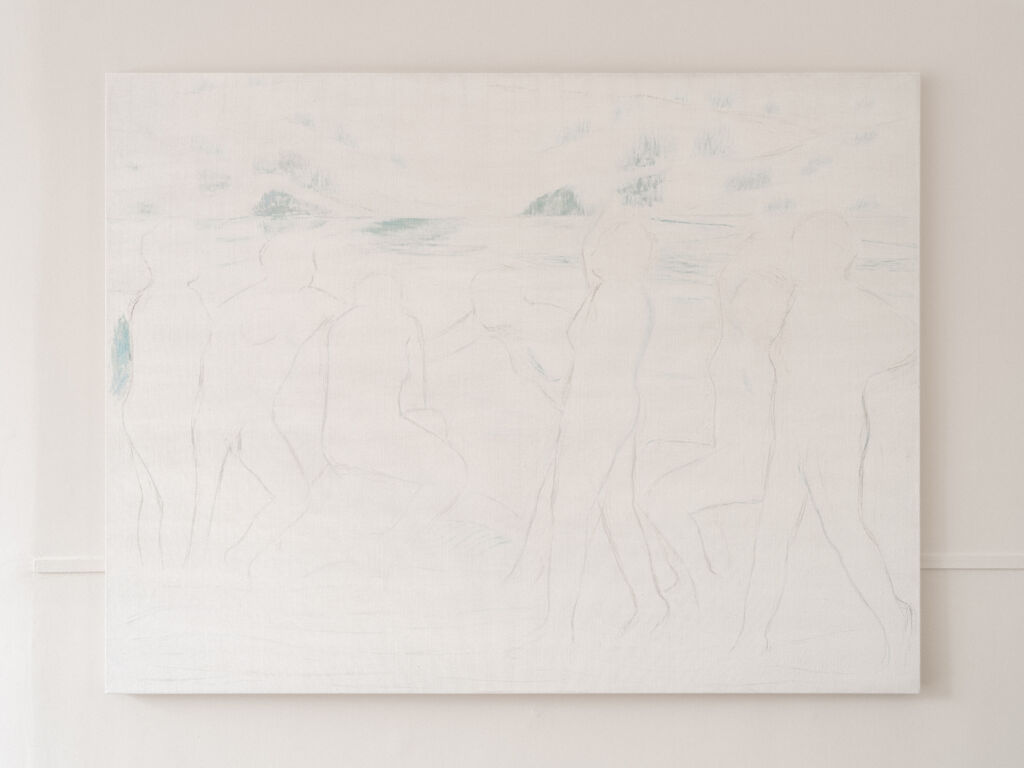
Adam Leef. ‘Bathers, 2019-2023′ Oil and charcoal on canvas. Photography by James Retief
Displaying past and present work, ‘Light Presences’ presents a survey of older to more recent work. ‘Self-Portrait as a Bather’, (2014-2019), for example, which stands as an homage to Cézanne’s ‘The Bather’ from 1885 hanging at the MoMA, New York, opens the exhibition along with ‘Bathers’ (2019-2023), a monumental oil and charcoal on canvas painting that feels more akin to an Henri Matisse. Throughout are other paintings and drawings, created over the space of a year or several years, as if each work was the result of a series of encounters and exchanges, sensitively had and permitted to delicately flourish. Hanging in the second ‘greenhouse’ room of the space, are more precise figurative depictions such as ‘Couple at Sea’ (2023-2024) and ‘Painter, Studio, Seascape’ (2023-2024). Representative of the artist’s most important nexus of people and places, Leef lets us in, sharing his very foundations – a generous and welcoming position in the context of his first solo exhibition in London.
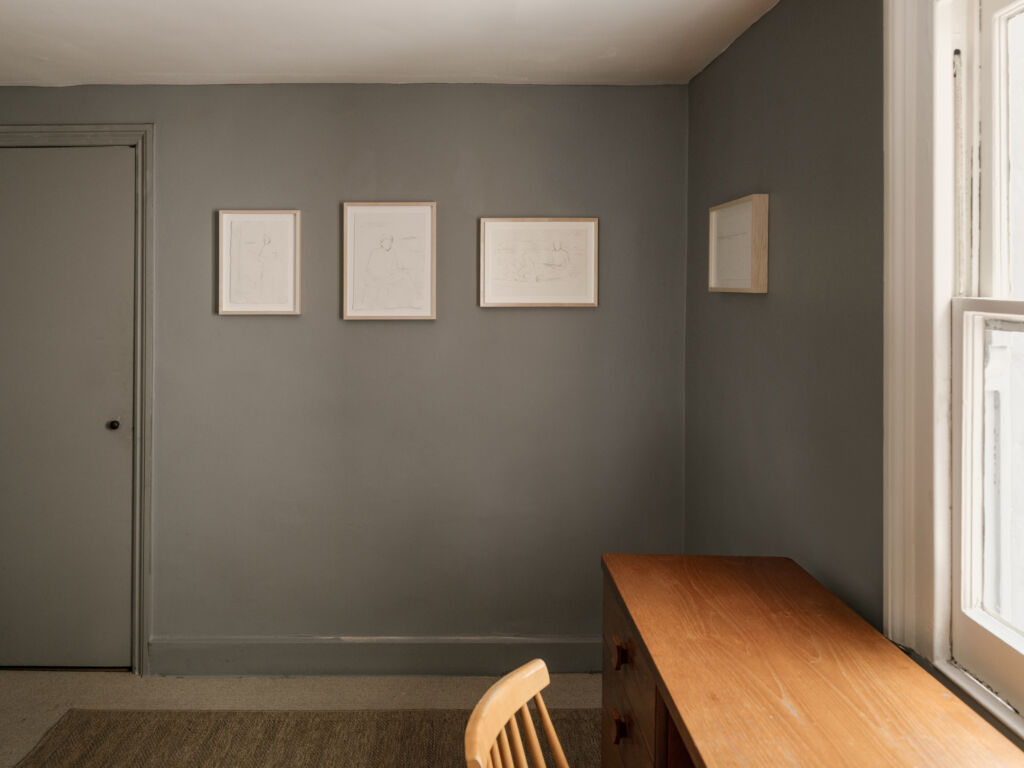
From left to right: ‘Painter, Studio, Seascape‘, 2023. Ink on paper. ‘Painter/Studio/Landscape‘, 2023. Ink on paper. ‘Couple at Sea‘, 2023. Ink on paper. Photography by James Retief
Ultimately ‘Light Presences’ is an evocative exhibition where delicacy is met by profound feeling; one that on the one hand transports us through art history yet is very rooted to a place, his beloved Mediterranean, far away from where the show is held. There is at once a sense of mnemonic recollection and an evocation of profound feeling; as with music, you can nearly hear each piece, as a whisper or murmur. Delicate yet present, the light expression of each piece creates space for our own senses, perceptions and feelings. Tender articulations of gesture and trace, Leef leads us into a vision of subtle and deliberate existence, where the entire picture might not be complete, but we are welcomed to slowly complete it with our experiences, thoughts and minds.
Text by Jenn Ellis
In conversation with Adam Leef.
‘I love composing spaces, framing spaces, lighting spaces… I think my drawings definitely come as a response to finding control and balance, to keep things in place.’

Artist Adam Leef captured by Yoav Arden in his studio, 2025.
Adam, your exhibition at Apsara Studio, Light Presences, marks your first solo show in London, showcasing both previous pieces and a newly created series of oil paintings and works on paper. Could you share insights into these series?
When I thought about this show, my first solo exhibition in London, I realized that I wanted it to be a personal and intimate exhibition—in fact, the most personal show I have exhibited to date. Some paintings and drawings are self-portraits or are of, or based on, my partner, Fernanda. Along with the bathers, which have been a main subject matter in my practice for years, this show gives a strong sense of what I have been working on over the past 4–5 years. The subject matter is nothing new, and I love working with motifs that have been pillars of visual arts throughout the centuries, as they allow me to tackle those questions of matter that so occupy the painter’s mind and hands. I can say that in the works presented in the upcoming show, it’s about extracting as much as one can from the subtle use of paint or ink strokes, and the evocation of space through the deliberate positioning of strokes and color nuances on the surface.
Questions of gesturality, art history, memory, and space have been recurring themes in your practice, forming the foundation for new harmonies and methods of expression, as you’ve described them. How do these themes influence your work, and what journey do you hope these works will take people on?
I never pretend to know how people will react to my work; some will like it, some won’t, and it’s all legitimate. I understood early on that I shouldn’t take people’s praise as well as their criticism—just focus on the work, and that’s it. However, I’m always thankful if someone comes and gives their time to look, whether at my work or anyone else’s, for that matter. There is something miraculous about watching people look at paintings in exhibitions, at the National Gallery, for example. Life is tough, life is full, and it’s not a natural or given situation in which one has the time and mental capacity to focus on art. So when one does, I’m thankful.
Regarding my work and the influences on it, I’ve always liked De Kooning’s quote that “painters don’t have bright ideas.” At the end of the day, I deal with very simple, or should I say, foundational, questions in painting that occupy my mind and develop over time. I’ve always strived for simplicity and clarity of expression, which, for me, are the highest aspirations—those delicate, nuanced moments that are so bare, yet still hold a world on their tip.
You seem to be interested in a variety of subjects, including landscapes, portraits, and the interplay between you, your studio, and the natural world. What draws you to revisit the subject of landscape, and could you walk us through the evolution of your work in this area?
I was fortunate to realize early on that the key, for myself, was the landscape. I love painting, I love painters, and I know them intimately—their biographies, stories, and whereabouts. As Gombrich said, “There is no such thing as art, only artists.” I understood that you cannot understand painting if you don’t know the geography of the artist. You can’t understand Diebenkorn if you don’t understand the Bay Area, you can’t understand Morandi if you haven’t seen Bologna, or Cézanne and Monet if you don’t know their surroundings. And the list goes on and on: Titian and Venice, Constable and England. For me, being trained in the “European Classical” methodology, the entrance was through the Mediterranean. I learned painting through tonality and sculpture, only to get rid of it over time in favor of other means of expression that I felt were more local. Landscape is a miraculous thing; it holds answers to so many painterly questions—depth and space, physicality, color harmonies. I was fortunate to work almost 10 years continuously in the Mediterranean, almost on a daily basis, and over time, I ventured out to meet new horizons, like Brazil, and at Xenia Creative Retreat in Hampshire, where I did a new landscape watercolor series. I guess I’m at a point where I feel comfortable enough to travel around and register new areas, as the base is strong enough.
Thank you, Adam!
Adam Leef began his artistic studies at age 15. He studied with painters Aram Gershuni, Ran Tenenbaum, and Guy Avital, as well as at the art departments of Haifa University and Shenkar College of Art and Design for limited periods. Early in his practice, Adam realized that the surrounding world and local environment could provide him with the essentials for the development of new harmonies and means of expression. Along with his studio practice, he began working continuously ‘En Plein Air’ in the landscape facing the Mediterranean, studying and embracing the unique light, colors, and physicality through different projects and series he has created for over a decade. This research allowed him to engage with the fundamental pillars of painting and reflect these perceptions onto his studio practice. Subject matters that occupy Adam’s work include landscapes, portraits, the relationship between the painter, his studio, and the landscape, bathers, and mythology. He is inspired by the broad history of the visual arts, and varied literary sources. Music also serves him as a significant source of inspiration in structure, movement within the painterly space, and the dynamics between the various elements within the work itself, corresponding and echoing one another while assembling a whole. Adam works mostly on series on paper and individual paintings on linen/canvas. He has exhibited 8 solo exhibitions in Israel, and in various group shows in Israel, England, France, and Italy, collaborating with curators such as Prof. Micha Levin, former director and head curator of the Tel Aviv Museum of Art. His works can be found in private collections in Israel, Europe, and the United States.
